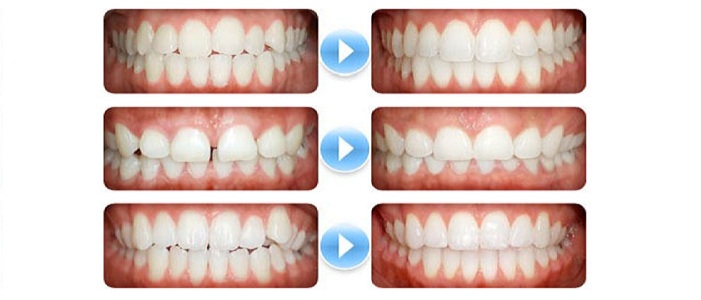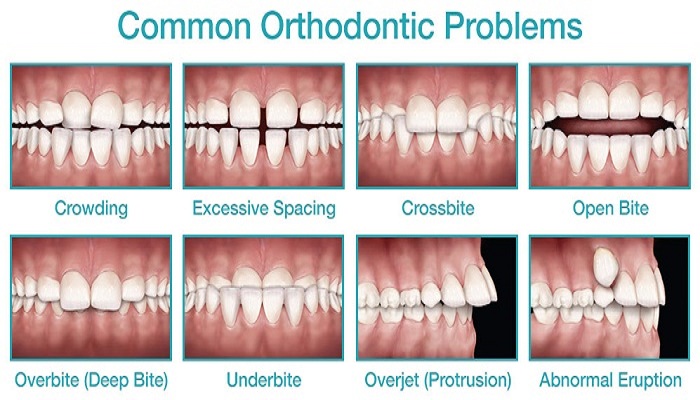Info Common Problems
Common Dental Problems
Common dental problems can be corrected with orthodontics to improve your smile. Malocclusions (improperly aligned teeth, bite, and/or jaw) should be treated as they affect the way you chew, your appearance, possibly your speech, and the way you feel about your smile.
Generally, the causes of malocclusions and orthodontic problems fit into three categories:
- hereditary,
- tooth loss,
- oral habits.
Common Dental Problems Cause Bigger Health Problems
Untreated malocclusions can result in a variety of problems including underbites, crowding, teeth protrusion, overbite and open bites. Many of these conditions, if left untreated as an older child or teen, may later require surgery or very extensive treatment to correct. Working with an orthodontist before becoming an adult to correct these conditions is often less costly than the treating more serious dental and health problems that can develop in later years.
There are certain abnormalities of the facial bones that could require orthognathic surgery (corrective jaw surgery) to correct the problem. Used in conjunction with orthodontic treatment, orthognathic surgery corrects difficulties associated with chewing, talking, breathing, and sleeping. If orthodontic treatment can correct the problem, orthognathic surgery may not be necessary. Using the latest advances in orthodontics, we will determine if orthognathic surgery is the correct treatment option for you.
Our office provides the best orthodontic care possible. We are committed to be on the cutting edge of all orthodontic technology, including digital imaging and 3-D dental imaging.
Common Dental Problems
Overbite correction is needed when the lower teeth bite into the roof of the mouth. The symptoms of an overbite are, of course, visually obvious. This condition can result in difficulty chewing properly and speaking clearly. An overbite can also be the source of jaw and neck pain and stress and even headaches. Over time it can lead to damage and wear of the jaw bone joint and uneven wear of tooth enamel. In normal situations, a natural overbite is about 3-5mm between faces of the upper and lower teeth.
Overbites are the most common malocclusion in children and can be either skeletal or dental.
- Skeletal overbites are genetically caused from a lower jaw that is smaller than the upper jaw. This may require orthognathic surgery (jaw surgery). The condition is most often
- Dental overbites are tooth-position related in nature and are usually corrected by orthodontic braces. The condition can be related to genetics or sometimes be due to extensive pacifier use, thumb-sucking, extended use of feeding bottles, or tongue thrusting at a young age.
Open bite correction is needed when the upper and lower front or incisor teeth do not touch when biting down. This causes all the chewing pressure to be placed on the back or molar teeth. Open bites can be classified as one of three types:
- anterior – the lower and upper teeth at the front of the mouth do not touch when biting down. Most often caused by genetics, but can be a results of thumb-sucking or chewing habits at a young age. Can also be a result of a tongue that is too large (macroglossia), tongue-thrusting, or TMJ (temporomandibular joint).
- posterior – the lower and upper molars at the rear of the mouth do not touch when biting down. It is a less common type of open bite often caused by molars not properly and completely erupting
- incomplete – where the lower front teeth do not touch the back of the upper front incisor teeth.
Often times, open bite treatment is needed because of oral habits, especially when the patient is young. Thumb-sucking, incorrect use of feeding bottles, and pacifiers can contribute to the development of this an anterior or incomplete open bite. These habits can cause the front teeth to flare out and with the jaw undeveloped, the teeth become misaligned. This condition greatly affects proper chewing and can possibly cause development of speech problems such as a lisp.
Crossbite treatment is needed when one or more upper teeth are behind the lower teeth. A crossbite, sometimes called a reverse bite is most often hereditary. The shape of the jaw bone and shape of the teeth are governed by genes inherited from both sides of your family. Also, other genetic predispositions can cause or worsen a cross bite such as delayed loss of baby teeth, irregular eruption of new teeth, and even enlarged tonsils or adnoids because of the mouth-breathing habit they cause. Though a crossbite is genetic, the condition can worsen due to careless chewing or thumb-sucking habits.
Crowded teeth treatment is one of the most common reasons patients seek orthodontic help. If your teeth are crooked, turned, or overlapped, your key orthodontic condition is probably crowded teeth. Generally, it is due to genetic traits of having a small jaw or relatively large teeth. Crowding can also be a result from habits such as nail-biting or thumb-sucking.
Crowding teeth occurs when teeth do not have sufficient room to erupt from the gum. Usually crowded teeth can be corrected by expanding the palate (widening the jaw) with tooth removal in most patients. Many patients also need braces to correct the alignment of the teeth. Typical treatment for crowded teeth involves the placement of highly detailed orthodontic “braces” on all the upper and lower teeth.
Diastema braces or other teeth spacing treatment options are necessary when the gaps between teeth are present. Tooth spacing or gaps generally occur when the teeth are smaller than normal and/or the jaws are larger than normal. When teeth do not fill the entire jaw, gaps between your teeth form. Teeth protrusion, missing teeth, or impacted teeth as well as abnormal tissue attachments to the gums can also cause teeth spacing issues.
Protruded teeth correction is needed when the upper front teeth extend too far forward or the lower teeth do not extend far enough forward. Sometimes referred to as “overjet”, the upper front teeth that protrude beyond normal contact with the lower from teeth are prone to injury.
Often the front teeth will have a flared appearance. Protruded teeth are often referred to as buck teeth.
Protruding teeth indicate a poor bite of the back molar teeth and may indicate uneven jaw growth. More often than not, dental protrusion is caused by jaw position, usually a hereditary factor. Thumb and finger sucking habits can also contribute to protruded teeth.
smile treatment is sought by patients who feel their smile is distracting. A “gummy smile”, technically known as excessive gingival display, is considered the most distracting conditions of many patients. While unlike many common dental problems that should receive orthodontic treatment, a gummy smile is not really detrimental to future oral or overall healthy. It is rather a cosmetic issue, but no less important as looking and feeling our best in social and professional situations is in our patients’ best interests.
The gingival appearance gives apparent imbalance in an excessive gingiva-to-tooth ratio. In other words, too much gum compared to the length of teeth is displayed.

